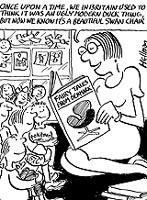Educated to be proud
In Denmark the whole nation gets behind its designers and this country could well afford take a leaf out of the Danes’ book.

The fact that the UK design industry is one of the world’s most successful passes by a large percentage of our public and, more alarmingly, many members of our business community. Why? My theory is simple, it’s down to a lack of celebration and education.
Ask schoolchildren what their perception of British design is – and I’m not talking five- to ten-year-olds – they will probably talk solely of catwalks, Posh Spice and perhaps, at a push, the older ones might be familiar with names like John Galliano or Alexander McQueen. It’s a limited repertoire.
So what, you might say? Well, I think it remiss of us not to promote design more publicly. It is far too elitist in this country and, ultimately, it’s the industry which suffers.
We could learn a lot by taking a leaf out of the Danish book. Design is undergoing a huge renaissance in Denmark. Everyone from bus drivers to pensioners seem capable of articulating lucid opinions on design, in a way which makes English seem like our foreign language.
There is a palpable pride among Danes in the achievements of their design heroes, who are treated as legends, as gigantic as any featured in a Hans Christian Andersen tale. They define their designers in terms of modern and classic. They talk about the creation of “timeless style”, something which has allowed their relatively small country to take a significant place in the world of international design. Names like Arne Jacobsen, Hans Wegner and Poul Henningsen trip off their tongues readily.
The Danish government has a dedicated policy of investment in design and it has paid dividends. You are as likely to see a group of old age pensioners or students discussing the merits of the exhibits at the newly opened Danish Design Centre, in Copenghagen, as you would design students or practitioners. And that’s as it should be. Design in the UK is far too elitist. While we are quick to proffer the label “designer”, the term has become a pejorative, applied for reasons of aspiration rather than substance.
There are many great examples of the prominence placed on design in Copenhagen. Take the recently opened, much debated and lauded addition to the Royal Library – a totally modern extension made of glass, concrete, black granite and steel which has become affectionately nicknamed The Black Diamond. Officially opened and given the royal seal of approval by Queen Margrethe 11, it would no doubt have been dubbed a monstrous carbuncle on the face of an old friendà by her British relations.
Another good example is Bang & Olufsen’s new flagship store (DW 18 February), which demonstrates the high level of ambition which permeates design in the Danish capital. The concept is built around a succession of different slides projected on to corrugated glass walls which form the interior shell. The aim, according to its design team, is to “create interaction between stability and flux, seriousness and playfulness, Scandinavian modernism and cultural multiplicity”. (At last, some common ground – they post rationalise the same way we do.)
Of course, no discussion about Danish design is complete without reference to Jacobsen – Mr Danish Design. Which leads me to a neat story. Amid the “throw everything out with the bathwater” 1980s, the powers that be at the SAS Royal Hotel, Copenhagen’s central high rise designed by Jacobsen, chucked out the now infamously desirable furnishings in favour of frills and twills.
Realising their mistake, they have at least taken the bold stance of reinstating the original look, in an extensive refurbishment programme. Someone, somewhere is surely kicking themselves for discarding original Egg and Swan chairs, now fetching a king’s ransom at auction.
Homage has also been paid to the visionary with the opening of Restaurant Jacobsen on the site of the designer’s original Bellevue complex built in the early 1930s The restaurant is as much a sociable museum to Jacobsen as it is a stylish place to eat. The full complement of Jacobsen chairs are on display, together with lamps, tables, clocks, posters and rare sketches. Above all else, this restaurant aptly exemplifies the pride Danes have in their design heritage and although it harks back to the past, it’s also a statement on the future.
Where there is discussion and appreciation, there is a bright outlook. Perhaps some day soon (before it’s too late) we will quit knocking and start to really celebrate what is great about British design. Our children will start to talk about Sir Norman Foster, James Dyson and Michael Peters as fluently as the Danes speak English. And our Government will up the ante on design education. I live in hope.
-
Post a comment




